Learning the guitar chords can be a daunting task, especially for beginners who may not know where to start.
I remember the first time I picked up the guitar. It was so difficult at first. I just couldn’t get the chord shapes down. It was both scary and frustrating.
But then with some dedication and a lot of practice I got a hang of all the basic chords and could swiftly transition from one chord to the another.
The first song I ever learned was “Boulevard of Broken Dreams” by my favorite band Green Day.
In the first few days, it felt choppy, but by the end of the month, I was able to play the song decently.
And that feeling, I just can’t put it in words.
When you finally learn to play your favorite song, it is a Sublime experience.
The point of mentioning this story is that just like any other skill, learning the guitar takes time and patience. You just don’t have to give up and keep going.
Remember, Rome was not built in a day!❌
Having said that, my goal here is to enlighten you with some of the most basic and popular guitar chords that every beginner guitarist should know.
Trust me, if you know these chords, you can pretty much play over 90% of the songs in the world.
So, take your time, learn these chords, master them, and begin your journey to the Awesome World of Guitar Playing!
WHAT IS A CHORD?
This is very important. Don’t skip reading this section.
Your understanding of the theory below will play a crucial role in picking you apart from other guitar players.
A chord is just a group of three or more notes played together. These notes are usually chosen from the same key or scale.
The combination of these notes creates a harmonious and pleasant sound that is unique to each chord.
The notes that make up a chord are called the “chord tones,” and they determine the quality of the chord.
The most basic chord is the triad, which is made up of three notes: the root, the third, and the fifth.
The root note is the starting point of the chord, and the third and fifth notes are chosen based on their relationship to the root note.
The third note can be either major or minor. For example, a major chord has a major third, while a minor chord has a minor third.
But it doesn’t stop there, my friend. Chords can also be extended by adding additional notes, such as the seventh, ninth, or thirteenth.
These extensions add even more complexity and richness to the chord.
Why Learn The Chords?
Learning the Basic chords mentioned in this blog post will give you a strong foundation for your musical journey.
Like building blocks, these chords will form the backbone of every song you play.
Once you master these basic chords, you will be able to play even more complex chords later.
Moreover, learning these chords will help you develop your finger strength and dexterity.
Your fingers will become more agile as you practice and play these chords over and over again.
Soon there’ll be a time, you’ll be able to play them without even thinking about the chord Name. It would come naturally to you. You’ll be able to anticipate exactly where your fingers will go next.
And once you reach that stage, you’ll be able to focus on the emotion behind the music, rather than struggling to get your fingers in the right place.
HOW TO READ THE CHORD DIAGRAMS/CHARTS?
Before you start learning these chords, obviously you must learn how to comprehend the chord diagrams.
Below is an example of a chord diagram.
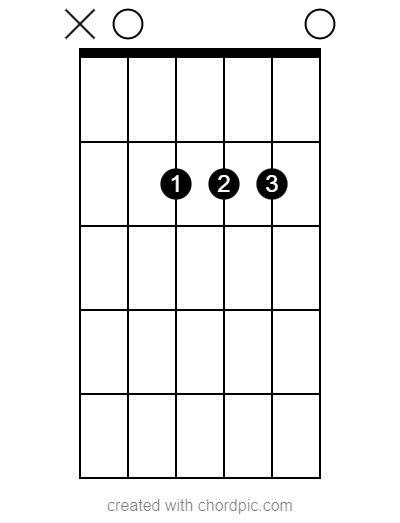
The vertical lines in the image above represent the strings on your guitar, while the horizontal lines represent the frets.
An empty circle tells you that the string should be plucked in the “Open” position. This means that you don’t have to place any finger behind any of the frets of that string.
“X” tells you that you shouldn’t pluck that string when playing the chord.
Pay attention to the numbers on the black dots. They indicate which finger to use on each string. For example, a “1” means to use your index finger, a “2” means to use your middle finger, and so on.
This may seem confusing at first, but with practice, it will become second nature.
And if you’re wondering what each string is called, they’re labelled as E, A, D, G, B, and E starting from the thickest to the thinnest string (or from the left to the right).
There’s an easy way to remember the string names. It is taught in almost every Music School and by private Guitar instructors as well.
E -Eddie
A – Ate
D – Dynamite
G -Good
B – Bye
E – Eddie
I hope, you will never forget the string names now!😜
So, now that we know what chords are and how to read the chord charts, we are in a position to start learning the 10 Basic Guitar Chords that every beginner guitarist should know.
Top 100 Hindi Songs to Play On Guitar
A MAJOR
The image we discussed earlier is actually an “A Major” chord.
“A Major” can be simply called an “A” chord.
In General, if you don’t see “Major” or “Minor” written after a chord, it is safe to assume that it is a major chord.
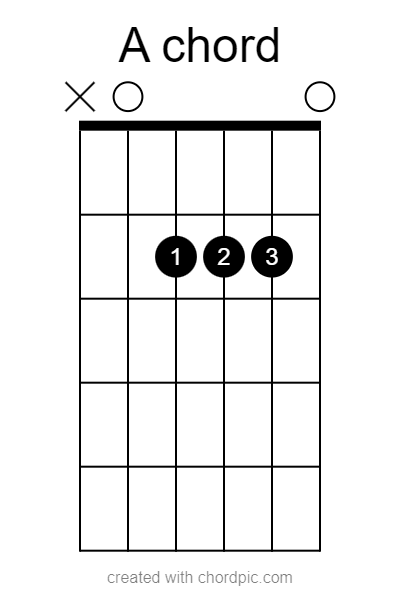
To Play the A major chord, Place your fingers on the second fret as shown above.
Your index finger should be on the second fret of the fourth string, your middle finger on the second fret of the third string, and your ring finger on the second fret of the second string.
Strum all six strings and listen carefully to ensure each note rings out clearly.
A MINOR
To play an A minor chord on the guitar, you first need to place your index finger on the second fret of the fourth string.
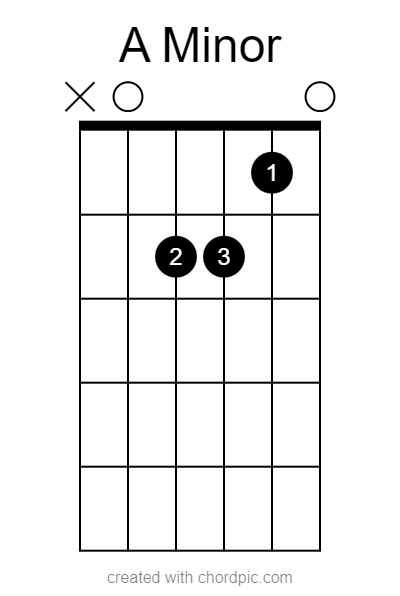
Then, place your middle finger on the second fret of the third string, and finally, place your ring finger on the second fret of the second string.
C MAJOR
To play a C major chord on the guitar, you first need to place your index finger on the first fret of the second string.
Then, place your middle finger on the second fret of the fourth string, and finally, place your ring finger on the third fret of the fifth string.

D MAJOR
To play a D major chord on the guitar, you first need to place your index finger on the second fret of the third string.
Then, place your middle finger on the second fret of the first string, and finally, place your ring finger on the third fret of the second string.
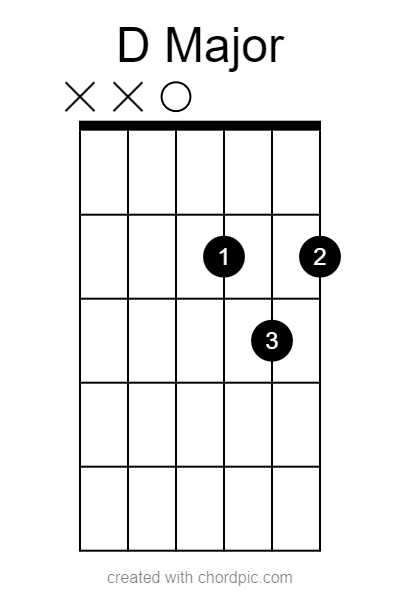
D MINOR
To play a D minor chord on the guitar, you first need to place your index finger on the first fret of the first string.
Now, place your middle finger on the second fret of the third string, and finally, place your ring finger on the third fret of the second string.
Be careful not to accidentally hit the lower two strings (E and A). We want the bass note to be the open “D” string for both the D major and D minor chords.
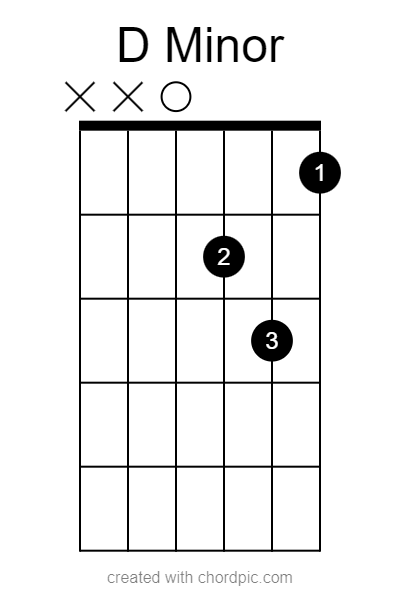
E MAJOR
To play an E major chord on the guitar, you first need to place your index finger on the first fret of the third string.
Next, place your middle finger on the second fret of the fifth string, and finally, place your ring finger on the second fret of the fourth string.
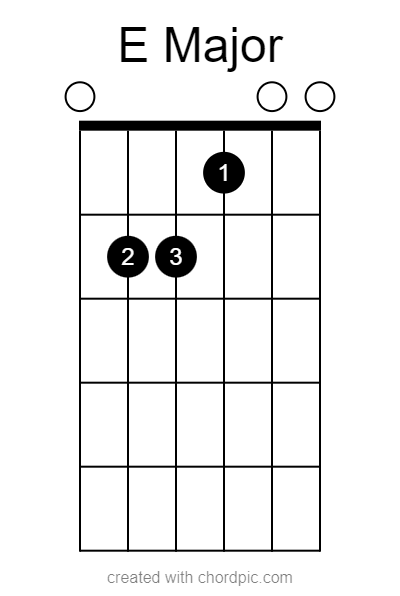
Make sure you let the open strings ring out as well.
E MINOR
To play an E minor chord on the guitar, Place your middle finger on the second fret of the fifth string, and then, place your ring finger on the second fret of the fourth string.
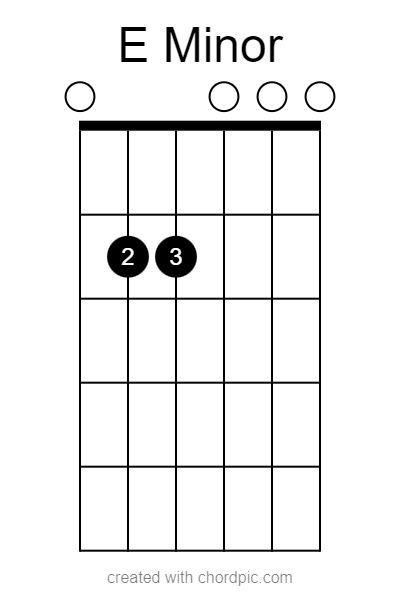
All other strings should be played in the “open” positions.
G MAJOR
To play a G Major chord, Place your index finger on the second fret of the fifth string, your middle finger on the third fret of the sixth string, and your ring finger on the third fret of the first string.

F MAJOR
To play an F Major chord on the guitar, begin by placing your index finger on the first fret of the second string, your middle finger on the second fret of the third string, your ring finger on the third fret of the fourth string and finally your pinky finger on the third fret of the fifth string.
This is an easy way of playing the F major chord.
Ideally, the F Major chord should be played as a Barred Chord where the first finger bars the entire first fret of your guitar.
I know, for beginners, it is very tough and painful.
But man, if you really want to excel at guitar, you will have to learn the barre chords at some point. So, it’s better to start practicing them right from the start.
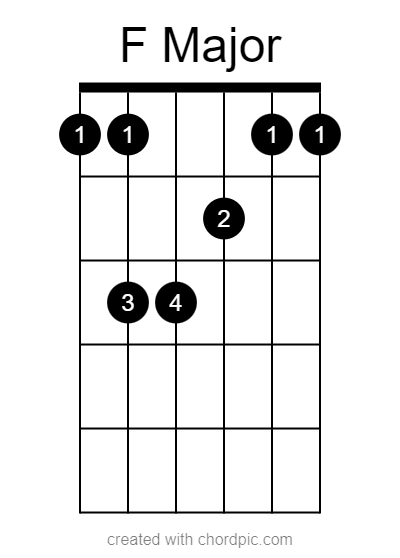
If you can’t play it at all, take some rest, cool off! And start over the next day.
Practice for 5 minutes every day and you will get it within a few days if not weeks.
Alternatively, if you want to play your favorite songs right in the beginning, you can do so by playing simplified versions of an F chord. Watch the video below to learn more.
B MINOR
Yet another barre chord. But, this is the last one, I promise.
It is important to learn this chord as many songs will have B minor in them.
To play the B Minor chord on the guitar, follow these steps:
- Place your index finger on the second fret of the fifth string.
- Place your middle finger on the third fret of the second string.
- Place your ring finger on the fourth fret of the fourth string.
- Place your pinky finger on the fourth fret of the fourth string.

Once you master the B Minor chord along with all the above chords, you’ll be all set to play any song in the world.
NEXT STEPS
Once you master these basic chords, you should practice them everyday.
Search on the internet for songs that use these chords, Play them.
Play your favorite songs, play your dad’s favorite song, your neighbor’s favorite song. Doesn’t matter!
The trick to getting better at guitar is to “Keep Playing”.
But, of course, there are a few other things you can do to improve your skills.
Once you are comfortable with each of the basic chords, try practicing transitioning between them smoothly. Start with two chords that are next to each other (such as C and G) and practice switching back and forth until you can do it without looking.
Then, gradually add in more chords and practice transitioning between them.
Once you can play chords smoothly, try practicing different strumming patterns to add variety and interest to your playing. Start with simple patterns and gradually work up to more complex ones.
If you want to take your playing to the next level, consider taking lessons from a guitar teacher or joining a group or class.
There are many chords beyond the basic chords that you can learn, such as seventh chords, suspended chords, and power chords. Look up chord charts or tutorials online to learn new chords and practice incorporating them into your playing.
One Golden Resource I can recommend is PlayGuitar. You will find plenty of Courses here for Guitarists of all skill levels.
And Of course, there is Google and YouTube, for everything else. Cheers!
SOME TIPS
After years of playing the Guitar, I can give you some tips to help you get started on the guitar, the right way.
✅ Begin with basic chords like C, G, D, and A before moving on to more complex chords.
✅ Use a metronome to help you keep time and play chords at a consistent speed. Start slow and gradually increase the tempo as you become more comfortable. I wish I had started my learning by using a Metronome!😕
✅ Make sure you are placing your fingers on the correct frets and strings. The tips of your fingers should press down on the strings, not the actual frets. This helps prevent unwanted buzzing or muted notes.
✅ Don’t just practice each chord individually, but also focus on smoothly transitioning between chords. Especially, learning how to transition smoothly from open chords to barre chords and vice versa.
✅ Chords should be played in time with the song, and the rhythm should be consistent. Pay attention to the strumming pattern and make sure you’re playing the chords at the right time.
MISTAKES TO AVOID
- Not Warming Up: Always warm up before playing chords to prevent injuries and improve your technique.
- Rushing through chords: Take your time when playing chords and focus on proper finger placement and technique. Speed will come with practice.
- Holding tension in your body: Relax your body when playing chords to prevent cramping and muscle pain. Don’t grip the guitar too tightly or hold your breath.
- Not using a tuner: Make sure your guitar is in tune before practicing chords to prevent frustration and improve your playing.
There are a few other things you should look at. Watch the video below to learn more.
CONCLUSION
Congratulations, my friend! You’ve made it to the end of our journey through the world of guitar chords.
By learning these 10 essential chords and practicing them with focus and dedication, you’ve taken the first step towards becoming a skilled guitarist.
Remember, learning to play guitar is a journey, not a destination. It takes time, patience, and lots of practice to develop the skills you need to become the musician you want to be.
Along the way, you may face challenges and obstacles, but don’t give up.
Keep pushing yourself, keep learning, and keep playing. Whether you’re strumming for your own enjoyment or playing for an audience, the magic of music is waiting for you
FAQS
How long does it take to learn guitar chords?
It really depends on how much time and effort you’re willing to put in. With consistent practice, you can start playing basic chords within a few weeks or months.
Can I learn guitar chords without a teacher?
Yes, you can learn guitar chords without a teacher. Many online resources, books, and videos can help you learn chords and techniques. I learned guitar all by myself. Never took any paid lessons.
Why do some chords sound bad when I play them?
There could be several reasons why some chords sound bad when you play them. It could be due to improper finger placement, not pressing down on the strings hard enough, or not placing your fingers in the right position.
How often should I practice guitar chords?
Consistent practice is key to improving your skills. It’s better to practice a little bit every day than to practice for long hours once a week. Aim for at least 30 minutes of practice each day and gradually increase your practice time as you become more comfortable.
Can I play chords on an electric guitar?
Yes, you can play chords on an electric guitar just like you can on an acoustic guitar. The main difference is in the sound produced, with electric guitars typically having a more amplified and distorted sound.
Where can I Learn All the Guitar Chords?
One good website is all guitar chords.
